Вестник Пермского университета. Серия: Экономика @economics-psu
Статьи журнала - Вестник Пермского университета. Серия: Экономика
Все статьи: 717

Статья научная
The article is devoted to modern issues of a monetary policy of the BRICS countries. Currently under the fragile economic situation the role of central banks is increasing; governments search for some new effective methods to stimulate economic growth. One of the key factors of progress is price stability support that is connected with a monetary policy and implementation of an inflation targeting. Nowadays this monetary policy framework has been adopted officially by most of the BRICS countries, but the issues concerning what methods and instruments should be used are still being discussed. The key issue of the discussion is whether it is necessary to set a flexible exchange rate arrangement under the inflation targeting conditions. In this connection, the expediency of a central bank to manage the national currency exchange rate is being discussed as it may conflict with the declared monetary policy. The main task of the present research is to assess the impact of a real effective exchange rate index that is considered to be an element of a monetary policy of the BRICS Central banks on a base interest rate. For this purpose an econometric model based on a modified Taylor's equation has been suggested. This model demonstrates the needs of developing economies of the BRICS countries for both price and exchange rate stability. Panel data analysis together with econometric modeling tools have been used to calculate the empirical part of the study. Regression coefficient assessments have proven the significance of these tools; the econometric modeling results have confirmed that Central banks of the BRICS countries mostly direct their attention to basis tools of the inflation targeting and economic agent expectations when achieving price stability. In the terms of the obtained data we may conclude, that it is necessary to consider an exchange rate when implementing a monetary policy in the BRICS countries. Further we will research 1) monetary policy in each of the BRICS countries in detail and will reveal long-terms connections among indices in the reaction equation of a central bank using co-integration vectors in a vector model of error correction; 2) interference of the policy of the BRICS Central banks and whether they are subject to globalization in the world finance sphere.
Бесплатно

Oil and gas complexes and clusters: identification and monitoring
Статья научная
The need to identify and to organize the regional monitoring of industrial complexes and clusters is based on their strategically important role in the regional development. Legal documents and scientific publications do not properly cover the methods for identifying cluster members as well as for assessing the effectiveness of cluster policy. The development of more accurate methods of assessing the role of the TPC and the clusters in the economic development of the region on the basis of accounting and statistical reporting is required to evaluate the effectiveness of fiscal support for complexes (Territorial-production complex, TPC) and clusters along with the application of econometric models. This article dwells upon the problems of this segment. The analysis of such concepts as cluster and territorial-production complex serve as a base for the examination of various forms of inter-economic interaction on the example of oil and gas industry in Perm Region. This analysis also justify the deduction about the absence of competition in the areas of oil and gas, as well as in the production of petroleum products, and the presence of oil and gas complex in the Perm region. The article contains the results of the analytical work on structuring of oil and gas complex in Perm region and the assessment of its impact on the value added in 2008-2013; also it provides the information about the generalization of limitations of the official statistics in the area of inter-firm linkages evaluation and gives the base for the necessity of using a model of analysis and evaluation of oil and gas complexes and clusters of generalizing indicator gross of value added. The article suggests to introduce additional fields in the Unified State Register of enterprises and organizations in order to form the results of the TPC and clusters quicker than previously. The article also validates the necessity of legal regulation of the access of municipal and regional authorities and management to statistical reporting of companies which significantly affect the indicators of socio-economic development of the territory.
Бесплатно

Optimization and resource distribution management in a national economy: the choice of structure
Статья научная
The purpose of the research is to develop resource management tools aimed to appropriately distribute the resources and to justify the ways for copying with the structure choice problem as regards the Schumpeterian approach to the economic development. The methodology of the research includes the Schumpeterian economic growth model, structural analysis, and conventional optimization methods, in particular the gradient projection method which gives alternatives for optimization task solution algorithms. These methods are applied to show the structures with the maximum profit and minimum risk in resource distribution in the national economy, which underlies the resource distribution management task. A model of interaction between the old and new combinations which are officially provided as investments into the old and cutting edge technologies was proposed within the Schumpeterian economic growth model. The economy restructuring was defined as the evolutionary changes of its structure under Joseph Schumpeter's theory, and the modes of the economic dynamics were identified from the correlation between the effects of creative destruction and combinatorial augmentation. The article describes the results of the optimizational simulation which prove that the Schumpeterian economy restructuring provides the prerequisites for new combinations which enhance the possibilities for their own development and for the development of the old combinations. The correlation between the profit and risk rates or expert decisions could become a criterion for decision making at a characteristic point. This fundamentally improves the quality of the managerial decision justification at different levels of an economic body which faces structural tasks of resource distribution. A structural choice problem together with its solution makes the priority task in the economic development of the managed system relevant. The research concludes that the structural policy is an essential element in the strategy aimed to develop a new model of the economic development of Russia, because, in fact, institutional changes and measures taken to create the business environment with no restructuring of the sectorial economic proportions look like the palliative aid with no prerequisites for the new type of economic growth. The research is seen to be promising in finding the particular solutions for resource distribution among the sectors and activity types according to the target functions of the economic system development. What is more, this issue updates the task to identify the impact of new combinations on the exising combinations, as well as to examine the factors which determine this impact. It would also be relevant to find the characteristic points of resource distribution for the particular tasks in the management of the national economy, e.g. state programs, which would enable the stakeholders to develop qualitative (expert) approaches to justify the resources distribution in an economic system.
Бесплатно
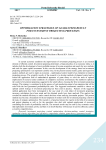
Optimization strategies of guaranteed result for investment projecting processes
Статья научная
In current economic conditions the improvement of investment projecting process is an essential element of efficient control. Investment projecting determines a financial policy of an economic entity as it includes both the development of most profitable means of income acquisition and search for new methods and tools for spare capital investment. In this case the development of the strategy based on investment projecting optimization is an important scientific issue. In the present research matrix games and regression analysis methods are used to make an economic - mathematical control model of an enterprise investment projecting process. The scientific novelty of the research is to develop methods of planned control and to extend the application field of mathematical apparatus of game theory to solve the tasks of optimal employment of recourses under conditions of competitive economic environment. The method to optimize the control of investment projecting suggested in the article allows choosing the best investment projecting strategy. This strategy is considered to be the process of such production output of an enterprise that will be soled with the best guaranteed profitability/risk ratio. The suggested econometric method to choose an optimal control strategy of investment projecting has been used in practice. Features of the suggested method application have been investigated in the case study of a real object of investment projecting, necessary calculations have been made and the obtained results have been analysed. This analysis has revealed the method efficiency to make control decisions when realizing investment projects. The present method may become a foundation for the development of modern tools for investment projecting control in the tasks of strategic optimization. The research is of practical interest for experts in the field of investment and project planning as well as for the specialists who deal with optimal employment of recourses considering the factors of profitability and risk. The research results may be used by any economic entity that implements investment activity and there is no doubt that they will increase its activity efficiency and as a result its competitiveness.
Бесплатно

Статья научная
The role of corporate social responsibility for the development of fundamental basis of social-economic interaction on sustainable development basis is significant for the existing corporate relations in the global economy. Corporate social responsibility means a voluntary initiative of separate corporations to implement a system social policy in the interests of society in general through the implementation of socially significant obligations established by laws, ethical standards, adopted rules of behaviour. In this regard the importance to study the corporate social responsibility phenomenon is that corporations with their socially significant behaviour predetermine social values in society in general and determine the vector of its socio-economic development. Considering the fact that the system of corporate social responsibility is based on labour relations incorporated into social-economic mechanism of a corporation and the mechanism in its turn is based on a company’s organizational structure the impact of an organizational structure on the corporate social responsibility practice is investigated in the research. The purpose of the article is to assess the impact of organizational structures of a company on the development of the systems of corporate social responsibility and to reveal differences in the corporate social responsibility systems of companies with different types of organizational structures. To achieve the aim of the study a theoretical review of approaches to understanding the essence of organizational structures and models of corporate social responsibility has been made. To analyse organizational structures we have used a synthetic approach that differentiates the structures into two types: mechanistic (with a high level of hierarchy and division of labour) and organic (flexible and better adapted to the rapid change of external conditions, including the emergence of new technologies). The hypothesis of the research is the assumption that companies with organic organizational structures are more progressive in the development of corporate social responsibility systems and the introduction of the principles of corporate social responsibility into their business practices. The study is based on social and ecological reports of Romanian companies that have more than 249 employees. The case-study method, interviewing, the tools of economic-mathematical analysis of data have been used in the research. While analyzing the contemporary status of the corporate social responsibility in Romania and 87 results of the questioning of the representatives of the Romanian companies we have come to the conclusion that despite the type of the organizational structure the key factors of the development of the system of corporate social structure are a company image and its reputation at the market, practice of purchasing (e.g. the compliance of the ethical code of a company by business partners and suppliers), the assessment of human rights in the company by business partners and industry trends of sustainable development. At that, the hypothesis that companies with mechanistic and organic organizational structures differently assess the role of the factors of corporate social responsibility. Thus, for companies with mechanistic organizational structures, image and reputation at the market, assessment of human rights by business partners, procurement practices, motivation and competence of personnel, and the absence of discrimination in remuneration of men and women are of fundamental importance in the development of corporate social responsibility systems. Companies with the organic type of organizational structure significantly appreciate the image and reputation at the market, as well as the level of internationalization of a company, the use of ECO labels, industry trends of sustainable development and production efficiency. As regards the advantages of the introduction of corporate social responsibility principles in the activities of companies, we have discovered that the differences are mainly observed in the average estimates of the analyzed factors in favour of companies with organic organizational structures. Results obtained in the investigation allow us to construct a profile of corporate social responsibility of companies with different types of organizational structures, to identify the advantages of the development of the system of corporate social responsibility and to make strategic priorities of socially oriented activity of a company more detailed. And further studies will be devoted to this aspect.
Бесплатно

P-адическое моделирование динамики индекса РТС в зависимости от таймфреймов
Статья научная
Главной предпосылкой изучения ценовых колебаний, происходящих на финансовых рынках, с помощью методов эконофизики является схожесть физических и экономических процессов. Оба процесса хаотичны, определены во времени, но не могут быть спрогнозированы на его основе. В качестве подхода для рассмотрения ценовых изменений выбран один из методов эконофизики - р-адический анализ. Целью исследования является применение методики р-адического моделирования и прогнозирования для колебаний цен на финансовых рынках, предметом - динамика индекса РТС. Приведено математическое описание р-адического анализа - определение р-адических чисел и их представление в пространстве . Оно является полным метрическим (порожденным р-адической неархимедовой нормой) пространством, что позволяет применять р-адические числа для моделирования стохастических явлений. Построены модели основных элементарных фигур динамики цен на финансовых рынках, таких как линейная функция, ступенчатая функция и волновая модель Р.Н. Эллиотта. В истории финансовых рынков найдены примеры, которые характерны для р-адического отображения. Сделана попытка создания методики по построению р-адических моделей и прогнозов, в соответствии с которой произведен анализ динамики индекса РТС. Для динамики индекса РТС построены четыре модели - по месяцам, неделям, дням и часам. Определены основные типы прогнозов, полученных на основе р-адических моделей, - оптимистичный, пессимистичный, усредненный и прогноз продолжающегося развития. Сделаны выводы о точности как р-адических моделей в зависимости от таймфреймов, так и их прогнозов в зависимости от выявленных типов. Найдены преимущества и недостатки р-адического анализа. Результаты исследований могут быть использованы для дальнейшего изучения волновых паттернов р-адическим отображением, применяемых не только к ценовым колебаниям, но и к другим экономическим процессам. Кроме того, р-адические модели могут выступать в качестве инструмента технического анализа.
Бесплатно
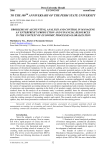
Статья научная
In Russia there has always been a very effective system of schools of thought, playing an important role in social development. They produce, propagate, defend scientific ideas and train young scientists at the same time. To review theoretical and practical results achieved by the school of thought at the Department of Accounting, Auditing and Economic Analysis. The review covers the period of 2005-2015. Attention is fo-cused on the analytical problems of theory and practice in business management, registration aspects of managing production and financial resources, problems of theory and methods in the development of auditing and control. The research is aimed at: formulating theoretical provisions and practical recommenda-tions for fiscal and management accounting development; functional and analytical representation and gen-eralization of theoretical foundations for the system of auditing activity regulation as well as analysis of directions for its further development; improving methods of economic potential analysis on the basis of the component approach to its integral assessment; constructing theoretical and methodological bases to bring the Russian financial statements in accordance with the international standards. The researches are based on the economic theory provisions, fundamental concepts of philosophy, social hypotheses. The system com-plex approaches, analysis and synthesis, induction and deduction, economic-mathematical modeling and programming, statistic methods and methods of sociological researches were applied. The school of thought has developed theoretical and methodical provisions to use and develop the fiscal accounting mechanism and the system of management accounting taking into consideration organizational and economic characteristics of enterprises and organizations operating in the fields of oil products supply, electrical engineering and ag-riculture; bases for the analysis of an economic entity’s economic potential; bases for structural transfor-mation of the main forms of financial statements according to the international standards; a model of the quality-oriented system of auditing activity regulation. Conclusions on theory and methods specify and de-velop the existing concepts of accounting, analysis and control. The research results can be applied in many spheres, they have been presented at conferences and introduced into the training process.
Бесплатно

Quality assessment of reporting on sustainable development of industrial enterprises
Статья научная
The practice of applying non-financial reporting by Russian companies has a relatively short history but the number of companies entering into the process, is constantly increasing. Since the quality reports can not do without analytical data interpretation, tracking dynamics of achieving the goals, response to the wishes of the parties concerned the methods and tools for making these reports must be chosen carefully. These criteria are developed by such different official and public organizations as World Bank, UNO, European Commission, World Wildlife Fund etc. Furthermore, this issue is being an object of many research works, but they generally tend to reflect the state of economic, environmental and social spheres of life in a static state. However, sustainable development is essentially a dynamic process, therefore, it requires development of a system of dynamic indicators which will take into account not only the balanced state of environmental, economic and social spheres, in a particular period of time, but also help to reflect the positive changes through the development process. We consider such dynamics indicators as growth rates of key performance indicators of enterprises as the most appropriate for this approach; they are grouped in three areas: social, economic and environmental. This dynamic model represents a procedure for the relative arrangement of indicators, the observance of which in a long time prospective will allow to assess the level of enterprise progress on the path of sustainable development. A distinctive feature of the proposed system is the possibility of measuring instruments to reflect the changes in each of the areas of sustainable development, as well as their interrelation in terms of balance and emerging imbalances.
Бесплатно
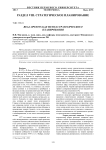
Real options как метод стратегического планирования
Статья научная
Метод реальных опционов широко применяется в ведущих зарубежных компаниях при принятии стратегических решений. Однако в российских компаниях этот метод известен в малой степени и редко применяется при разработке инвестиционных проектов и в процессе стратегического планирования. В статье дается описание метода реальных опционов как одного из основных методов стратегического планирования.
Бесплатно
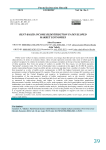
Rent-based income redistribution in developed market economies
Статья научная
Public-sector workers in many countries earn more, on average, than their private-sector peers with similar characteristics. In terms of economic theory, these rewards represent economic rents most of which paid by a nation’s taxpayers. In contrast to economic rents accruing to recipients at the top of income distribution, most of these payments flow from one group of workers to another. For this reason, we call these payments “horizontal” economic rents. The level of horizontal rents is analyzed in this paper for 28 OECD countries, mostly representing Europe, based on public-private sector pay gap data from a number of studies. We found that measured as a ratio of public-sector overpayments to GDP, the highest horizontal rents are paid to government workers in Mediterranean EU countries. These rents are relatively low in larger EU countries, such as Germany and the United Kingdom and negative in Scandinavian countries, possibly reflecting the recognition of the non-monetary benefits of public employment, such as job security. Analyzing the determinants of horizontal rents, we found that their levels are lower in countries with stronger trade unions, as measured by trade-unions density and higher in countries with larger foreign-born populations. Macroeconomic variables, including GDP per capita, trade openness, labor force participation and government indebtedness were found to not measurably influence the level of horizontal rents. Further research is seen to be connected with a wider range of the countries under analysis, including the developing countries, and the other groups of employees with the horizontal economic rent, as well as the possible ways to decrease or to invalidate it as regards the practices analysis of the countries with the negligible or negative rent such as Denmark, Norway, Sweden, Portugal, and Iceland.
Бесплатно

Статья научная
Recently the global trend to organize the activities of companies in different spheres and sectors of the economy on the project principle has become more relevant and acute. Heads of companies currently pay particular attention to the assessment of the result of the project and find the factors that affect its success. At the first stage of development of this problem, the researchers focused on the study of the indicators of the “iron triangle”, on the achievement the strategic goals of the company or on the meeting the interests of the project customers. Contemporary scholars focus on a wider range of project success factors, their ambiguity and multi-dimensionality. Organizational culture of a project is one of the most important factors as, on the one hand, its impact is well recognised, but on the other hand it is difficult to identify its impact as the culture interacts with other factors. Therefore, it is difficult to determine the boundaries of the impact. However, extending the success factors of a project to include aspects of organizational culture provides managers with an additional tool to achieve project results. The purpose of the article is to test the OCPS (Organizational Culture - Projects Successful) method that has been modified by the author according to the features of the Russian economy. The method allows determining the impact of organizational culture on the project success in different branches of activity. The research is based on a systematic and synergistic approach that considers the project success as a complex system in which the effect of the control action is not directly proportional to the efforts made. This is due to a wide range of possible factors that affect the success of the project, a high degree of uncertainty of the environment, as well as a variety of internal impulses of an organization. The method has been applied and tested in the case study of companies operating in a construction industry as a project is the main type of business for them. In this sector of economy, projects can attract large cash flows. However, unsuccessful projects lead to financial instability of a company. Qualitative and quantitative methods have been used in the study. The main results that have been obtained are 1) the determined aspects of organizational culture that affect the project success in the organisations operating in construction industry of economy: teambuilding, external communication and leadership; 2) the generation of criteria for their assessment and recommendations on the use of the identified aspects of organizational culture in order to increase the probability of success of construction projects. For this purpose a matrix of levels of success of construction projects has been proposed. The application of the matrix allows quickly responding to the problems existing in the project team. The obtained scientific results will allow project managers to get an additional tool to study the aspects that affect the success of an organization’s projects, as well as to identify the elements, influencing on which increases the opportunity to achieve project results. Further studies will be devoted to the testing of the suggested method in the case study of projects made by companies operating in other branches of economy. Subsequently, it will verify the method in the context of applicability to organizations regardless of their sphere of activity.
Бесплатно
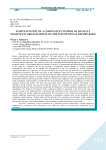
Статья научная
The issues concerning public welfare and sustainable growth that is possible when economic agents behave conscientiously are currently significant. The main purpose of the present study is to substantiate economically the role and the main points of a compliance control as an institute which aim is to reduce stakeholder's risks and to provide a sustainable growth of socially significant organisations that make a national economy function efficiently. The research is based on a theoretical methodological apparatus of an institutional economic theory, a risk-oriented approach, methods of analysis, systematization and generalization. The novelty of the study is a different view on the concept “a compliance control institute of socially significant organisations” that allows us to estimate the consequences of the low breaking by socially significant organisations that occur in the form of costs growth and risks of agents who are interested in a sustainable and conscientious transaction. The trends and types of the compliance control have been determined. These trends consider a social and economic role of organisations that are being controlled and areas where compliance risks arise. Considering the features of socially significant organisations and their classification we have characterised institutional relations, determined possible conflicts of interest and compliance risks, distinguished the functions of the compliance control institute, revealed the role of an institutional structure of the compliance at three levels (internal, external and public). We have also discovered factors that prevent efficient functioning of the institution. In our research we have proven that the institute of a compliance control is significant to reduce opportunistic behaviour risks that threaten sustainable development of socially significant organisations and their stakeholders. The efficient development of the compliance institute is connected to the need of the state and society to assist in the implementation of functions and mechanism of the enforcement to internal audit and internal control by socially significant organisations. The assessment of the control procedure quality by the socially significant organisations and their opposition to legislation violation risks are also important for the compliance control institute. Further studies will be devoted to the construction of a hierarchy of the compliance control institution with a clear division of control tasks at internal and external levels. Also a set of solutions to increase the efficiency of the implementation of the compliance control functionality will be made.
Бесплатно

The boundaries of economic feasibility of tax incentives for innovative businesses
Статья научная
Innovative development of Russia and the region is impossible without well-developed innovation infrastructure, and, in particular without those elements of it that provide financial support to innovative businesses. A special role is played by the public institutions aimed at promoting the innovation activity. The provision of tax incentives for innovative businesses should be considered as the most recent form of the government support. This does not require the State to divert the existing financial resources but just not to take out the funds earned by the businesses. The article shows that there are objectively determined boundaries of the economic feasibility of tax privilege for income tax for innovative businesses, whereby a balance of state interests and needs of businesses that implement innovative development programs is provided. The authors have developed a method of rapid analysis of innovative programs of businesses, focused on practical application, that enables finding economic parameters under which the government expenditure for financial support of businesses is compensated by the increase in payments to the income tax budget from those businesses. This method allows for formation of a normative structure that defines the border lines for Tax Incentives Economic Feasibility for supporting the innovation activities of businesses. These normative values are advisable to lay in the local normative acts that govern activities of government agencies for financial support of businesses implementing the innovative programs. They are easy to use for conducting all sorts of competitions of the innovative businesses as well as for making decisions on the government support of modernization programs of production of industrial corporations.
Бесплатно
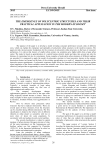
The emergence ofpolycentric structures and their practical application in the modern economy
Статья научная
The purpose of the paper is to develop a model revealing consumer preferences towards cities of different sizes, which can explain the emergence and optimality of polycentric urban structures in the modern economy. The paper provides microeconomic foundations for the existence of polycentric urban structures on the basis of consumer preferences. It is shown that clusters of smaller urban centers can sometimes give higher utility than a large urban center. The model is based on generalization of a central business district model and takes into account not only the distance of commuting, but also its convenience. Some examples of polycentric urban structures of different topology are provided. It is proposed to apply the model of polycentric structure to form innovative clusters in the regions. Innovation clusters are formed on the basis of the existing specialization as a result of integration interaction of the innovative process participants. A polycentric structures model allows for formation of innovative clusters in regions when integration of the cluster members around the scientific core allows them to use the innovative potential more effectively and provides an opportunity to save on transaction costs.
Бесплатно
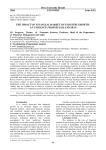
The impact of financial market on industry growth: an evidence from Russia and Iran
Статья научная
The relationship between financial markets and industry growth has been approved by many previous studies. In this paper, as an innovative research, we try to find the impact of market capitalization in financial market as a proxy for financial market on the industry growth in Russia and Iran. In fact, these two countries are classified as developing economies in which the financial markets can play a powerful engine to improve the industries’ performances. Hence, it would be interesting to compare market capitalization-industry growth nexus in Russia and Iran as two developing countries. In order to fulfill this purpose, an econometric model called Vector Autoregressive Model (VAR) is applied for the annual data over the period of 1992-2014. The finding proves the positive relationship between market capitalization and industry growth in both countries, Iran and Russia. Based on the results, a 1% increase in market capitalization in Iran and Russia increases the industry growth by 0.07% and 0.02%, respectively. It has been concluded that market capitalization can play a significant role in order to grow the industry in Iran and Russia. However, these two countries need to improve the efficiency of their financial markets to improve the positive impact of these markets on their industrial growth. The novelty of this research can be highlighted in this way that the financial market in oil exporting countries, Russia and Iran as our case studies, may be a golden key to reach to a positive and stable economic growth. Thereby, oil exporting countries should try to implement good financial policies and improve the efficiency of financial market.
Бесплатно
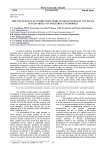
Статья научная
In modern conditions, sustainable development is the object of study in economic science. The study of this important issue is actual both at macro-, meso- levels, and at the enterprise level. Major problem is to achieve the balance between economic, social and environmental aspects of economic systems. Therefore, there is need for investigate the relationship and mutual indices characterizing the economic, social and environmental sustainability. The authors propose to use the method of correlation analysis to identify the relationships. The concept of concepts of economic, social and environmental sustainability of the industrial enterprise is specified in the article, indicators by which it is possible to estimate the condition of three observed kinds of sustainability is proposed. Analysis of the key indicators was done on the basis of information given by the Territorial State Statistics Service. Correlation analysis was performed to show the influence of the economic indicators of industrial enterprises of the Perm region on their social and environmental sustainability. As a result of analysis, it was found that the economic indicators characterizing economic growth at the enterprise level have a significant influence on social and environmental sustainability. It has been established that the economic well-being of companies, estimated by quantitative growth, financial performance and attractiveness to foreign investors, in general, has a positive effect on social stability. The impact of economic indicators on environmental sustainability is ambiguous: on the one hand - there are positive trends, which include reduction of emissions, decrease of electricity consumption; on the other hand there is the achievement of economic stability in contradiction with the use of such an important resource as the land.
Бесплатно

The nanolevel of economic hierarchy
Статья научная
The range of issues related to an individual is crucial for modern economics. It is possible to talk about appearance of nanoeconomics as a new branch along with the traditional micro- and macroeconomic theories. The main objective of the research is to analyze the achievements of various scientific schools concerning nanoeconomics. In the research methods of historical and comparative analyses are used. As for the novelty of the work, the issues of nanoeco-nomics are considered here in terms of hierarchical analysis. Behavioral economics denies the idea of economic agents rationality; evolutionism is based on bounded rationality; neoinstitutionalism and ethical economics preserve the concept of rationality in the theory developing criteria for rationality of higher orders (metarationality). Evolutionism rejects neoclassical economics and suggests a new paradigm; behavioral economics criticizes the axiom of rationality, but it is still not clear what changes into the theory it entails; neoinstitutionalism broadens and deepens the neoclassical theory maintaining its core; ethical economics develops the neoclassical model as its own special case. Neoinstitutionalism is like economic imperialism that tries to extend the methods of economic analysis on issues of other fields such as sociology. Behavioral economics is, rather, expansion of psychology into economics; evolutionary theory - biology expansion into economics; ethical economics - ethics expansion into economics.
Бесплатно
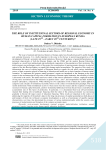
Статья научная
The issue of national and historical features of human capital was broadly discussed by public thought and academic discourse. It is vitally important in the sense to be the key to perceiving perspectives of the development of Russia’s economic and social institutions. Moreover, high degree of spatial differentiation is a persistent characteristic of both the Russian Empire, and the USSR, and the modern Russian Federation, primarily as a result from multinational and multicultural composition of the population of their territories. The article presents our preliminary results of the project for reconstruction of macroeconomic dynamics in selected regions of the late Russian Empire, as regards their human capital accumulation. The purpose of this study is to demonstrate the cases of selected regions of European Russia as regards the role which various institutional sectors of their economies played in financing of education and health care as basic branches of human capital formation. To implement this purpose annual governors’ reports are introduced to the literature as the main source for the reconstruction of long series of the indicators of human capital industries, the reliability of which is discussed in the article. The author used cross-check of the sources quantitative evidence, employed methods of long series reconstruction of the indicators in question (inter-, retro-, and extrapolation) and their statistical analysis (descriptive, comparative). When offering his own explanation of the evidence the author applied to categories and concepts of institutional economic history in the context of modernization paradigm. The first results demonstrate which institutional sectors to what extent were the sources and the recipients of financial resources for human capital formation, and how institutional differences between the provinces could affect the accumulation rate of this factor of production. In particular, it is documented that local self-governments retained their leading role in healthcare financing while the share of the central government was increasing gradually to become the major source of education financing. These results are important in the context of addressing the inquiries of the period’s place in the long run processes of capital accumulation (both physical and human); of their role in Russia’s economic development; as well as of persistence of specific regional characteristics over time, that determined the existence of various institutional paths within the country-wide processes of modernization and formation of the common economic space.
Бесплатно

Статья научная
В статье представлены основные результаты разработки агент-ориентированной модели инновационного процесса появления, отбора и реализации инновационных проектов. Приведено концептуальное описание механизма работы модели. Предложен новый подход к моделированию и исследованию проблем инновационного развития, позволяющий получить как качественные, так и количественные оценки эффекта воздействия на инновационную систему.
Бесплатно

Агрегированная производственная функция с учетом научно-технического прогресса для экономики России
Статья научная
Рассматривается проблема агрегирования производственных функций как моделей производственных процессов на региональном и национальном уровнях экономики России. Проблема агрегирования была впервые сформулирована в 40-е гг. XX в. на страницах журнала Econometrica, однако остается нерешенной до сих пор. Данная задача является частной в рамках более широкого направления исследований, связанного с изучением «мостов» между микро- и макроэкономикой. Развивается статистический метод агрегирования производственных функций, предложенный пермской школой иерархического анализа экономики. Цель работы состоит в адаптации данного метода агрегирования для экономики России. Предлагается модификация метода для случая неравномерности распределения ресурсов между элементами экономики. В работе представлены оценки параметров «инвестиционной» производственной функции Кобба - Дугласа для всех регионов России. На основе региональных производственных функций осуществлен синтез агрегированной производственной функции для экономики России. При построении агрегированной производственной функции учитывается фактор научно-технического прогресса. Оценки параметров агрегированной производственной функции для экономики России получены на базе программного комплекса «ПРОГНОЗ. СБСП СЭР». Установлено, что выведенная производственная функция обеспечивает более точные прогнозы по сравнению с традиционной макроэкономической производственной функцией Кобба - Дугласа. На основании агрегированной производственной функции получена оценка ВВП России на 2015 г., построен прогноз на 2016-2018 гг. и проведен анализ производственных процессов в экономике России: рассчитаны коэффициенты эластичности по факторам производства, предельная норма замещения и эластичность замещения между факторами производства. Согласно полученному прогнозу в 2015 г. по базовому сценарию в России ожидается спад экономики на 2,6%, в 2016-2018 гг. экономика начнет восстанавливаться, темпы экономического роста составят 2-2,5% в год.
Бесплатно

